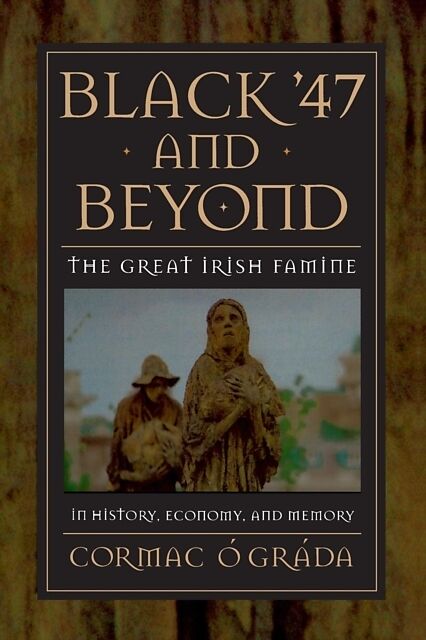Black '47 and Beyond
Einband:
Kartonierter Einband
EAN:
9780691070155
Untertitel:
The Great Irish Famine in History, Economy, and Memory
Autor:
Cormac Ó Gráda
Herausgeber:
Princeton University Press
Anzahl Seiten:
316
Erscheinungsdatum:
03.09.2000
ISBN:
0691070156
Zusatztext "Cormac Ó Gráda, Ireland's most distinguished, prolific and wide-ranging economic historian, offers us a choice selection of six chapters. . . . The great value of the book lies in pushing the boundary of Irish famine studies beyond their accustomed limits and by including suggestive comparative references to famines in other times and places. By concentrating on a few topics, Ó Gráda can share with the reader the wealth of his broad scholarship and technical mastery." ---Barbara Solow, The Times Higher Education Supplement Informationen zum Autor Cormac Ó Gráda is Professor of Economics at University College, Dublin. His most recent works include Ireland: A New Economic History and A Rocky Road: The Irish Economy since the 1920s. Klappentext Here Ireland's premier economic historian and one of the leading authorities on the Great Irish Famine examines the most lethal natural disaster to strike Europe in the nineteenth century. Between the mid-eighteenth and early-nineteenth centuries, the food source that we still call the Irish potato had allowed the fastest population growth in the whole of Western Europe. As vividly described in Ó Gráda's new work, the advent of the blight phytophthora infestans transformed the potato from an emblem of utility to a symbol of death by starvation. The Irish famine peaked in Black '47, but it brought misery and increased mortality to Ireland for several years. Central to Irish and British history, European demography, the world history of famines, and the story of American immigration, the Great Irish Famine is presented here from a variety of new perspectives. Moving away from the traditional narrative historical approach to the catastrophe, Ó Gráda concentrates instead on fresh insights available through interdisciplinary and comparative methods. He highlights several economic and sociological features of the famine previously neglected in the literature, such as the part played by traders and markets, by medical science, and by migration. Other topics include how the Irish climate, usually hospitable to the potato, exacerbated the failure of the crops in 1845-1847, and the controversial issue of Britain's failure to provide adequate relief to the dying Irish. Ó Gráda also examines the impact on urban Dublin of what was mainly a rural disaster and offers a critical analysis of the famine as represented in folk memory and tradition. The broad scope of this book is matched by its remarkable range of sources, published and archival. The book will be the starting point for all future research into the Irish famine. Zusammenfassung The Irish famine peaked in Black '47, but it brought misery and increased mortality to Ireland for several years. This title presents the Great Irish Famine from a variety of perspectives. It concentrates on fresh insights available through interdisciplinary and comparative methods. It highlights several economic and sociological features....
Autorentext
Cormac Ó Gráda is Professor of Economics at University College, Dublin. His most recent works include Ireland: A New Economic History and A Rocky Road: The Irish Economy since the 1920s.
Klappentext
Here Ireland's premier economic historian and one of the leading authorities on the Great Irish Famine examines the most lethal natural disaster to strike Europe in the nineteenth century. Between the mid-eighteenth and early-nineteenth centuries, the food source that we still call the Irish potato had allowed the fastest population growth in the whole of Western Europe. As vividly described in Ó Gráda's new work, the advent of the blight phytophthora infestans transformed the potato from an emblem of utility to a symbol of death by starvation. The Irish famine peaked in Black '47, but it brought misery and increased mortality to Ireland for several years. Central to Irish and British history, European demography, the world history of famines, and the story of American immigration, the Great Irish Famine is presented here from a variety of new perspectives. Moving away from the traditional narrative historical approach to the catastrophe, Ó Gráda concentrates instead on fresh insights available through interdisciplinary and comparative methods. He highlights several economic and sociological features of the famine previously neglected in the literature, such as the part played by traders and markets, by medical science, and by migration. Other topics include how the Irish climate, usually hospitable to the potato, exacerbated the failure of the crops in 1845-1847, and the controversial issue of Britain's failure to provide adequate relief to the dying Irish. Ó Gráda also examines the impact on urban Dublin of what was mainly a rural disaster and offers a critical analysis of the famine as represented in folk memory and tradition. The broad scope of this book is matched by its remarkable range of sources, published and archival. The book will be the starting point for all future research into the Irish famine.
Zusammenfassung
The Irish famine peaked in Black '47, but it brought misery and increased mortality to Ireland for several years. This title presents the Great Irish Famine from a variety of perspectives. It concentrates on fresh insights available through interdisciplinary and comparative methods. It highlights several economic and sociological features.

Leider konnten wir für diesen Artikel keine Preise ermitteln ...
billigbuch.ch sucht jetzt für Sie die besten Angebote ...
Die aktuellen Verkaufspreise von 6 Onlineshops werden in Realtime abgefragt.
Sie können das gewünschte Produkt anschliessend direkt beim Anbieter Ihrer Wahl bestellen.
Loading...
Die aktuellen Verkaufspreise von 6 Onlineshops werden in Realtime abgefragt.
Sie können das gewünschte Produkt anschliessend direkt beim Anbieter Ihrer Wahl bestellen.
| # | Onlineshop | Preis CHF | Versand CHF | Total CHF | ||
|---|---|---|---|---|---|---|
| 1 | Seller | 0.00 | 0.00 | 0.00 |
